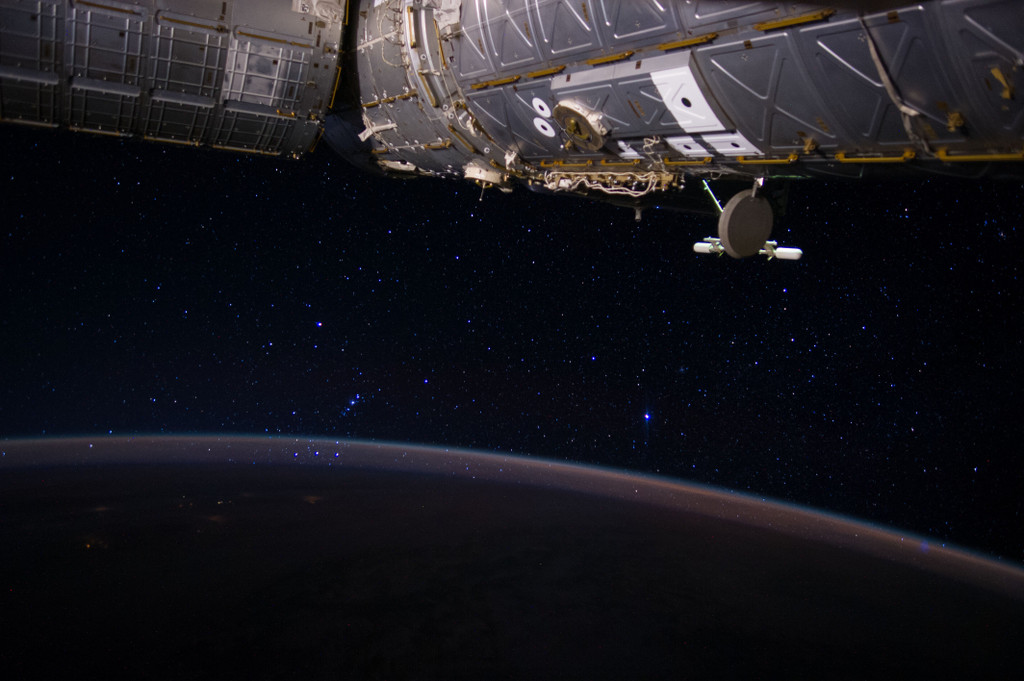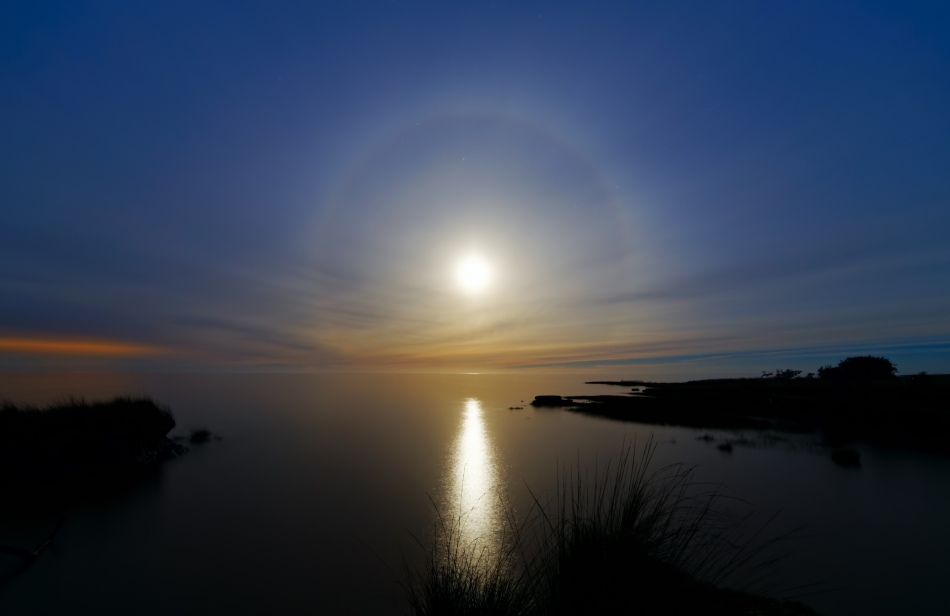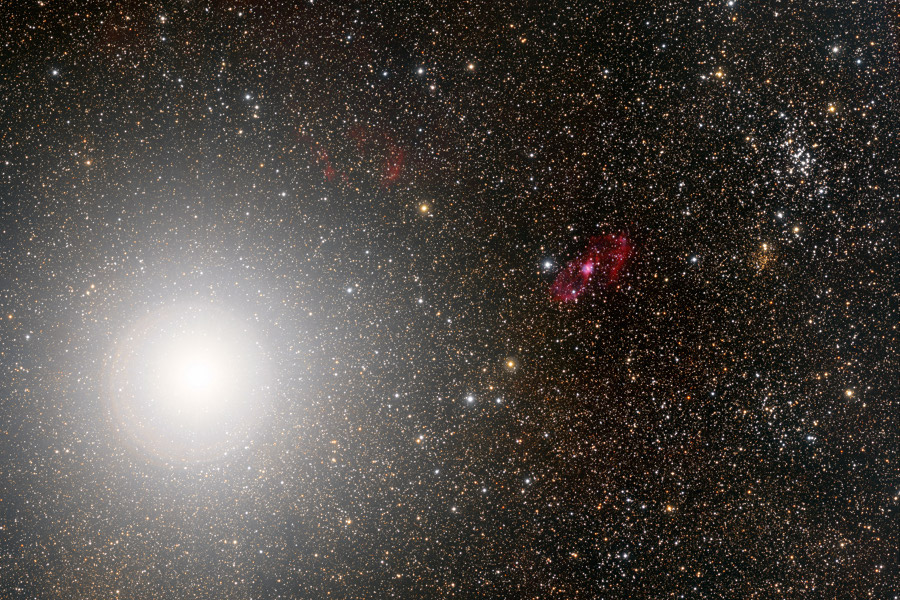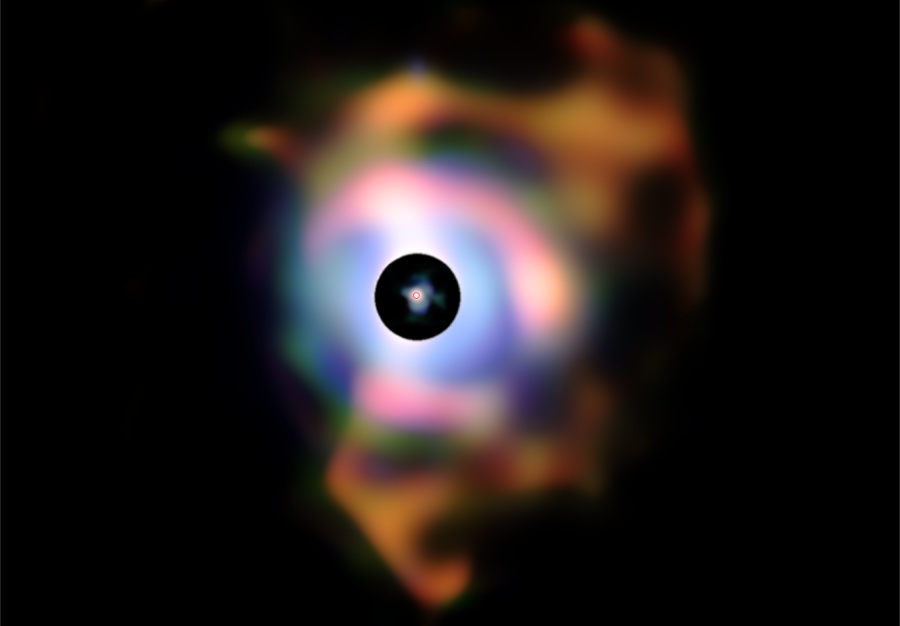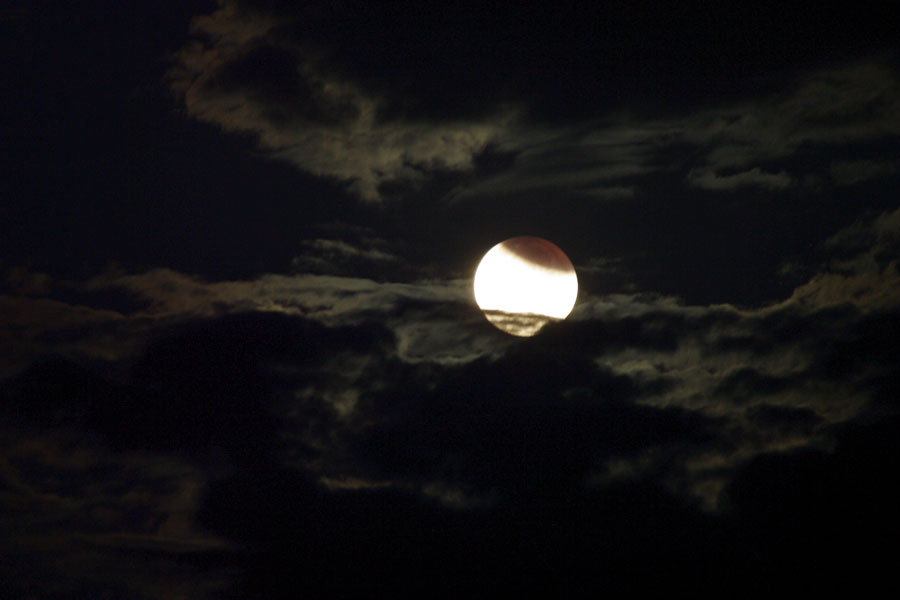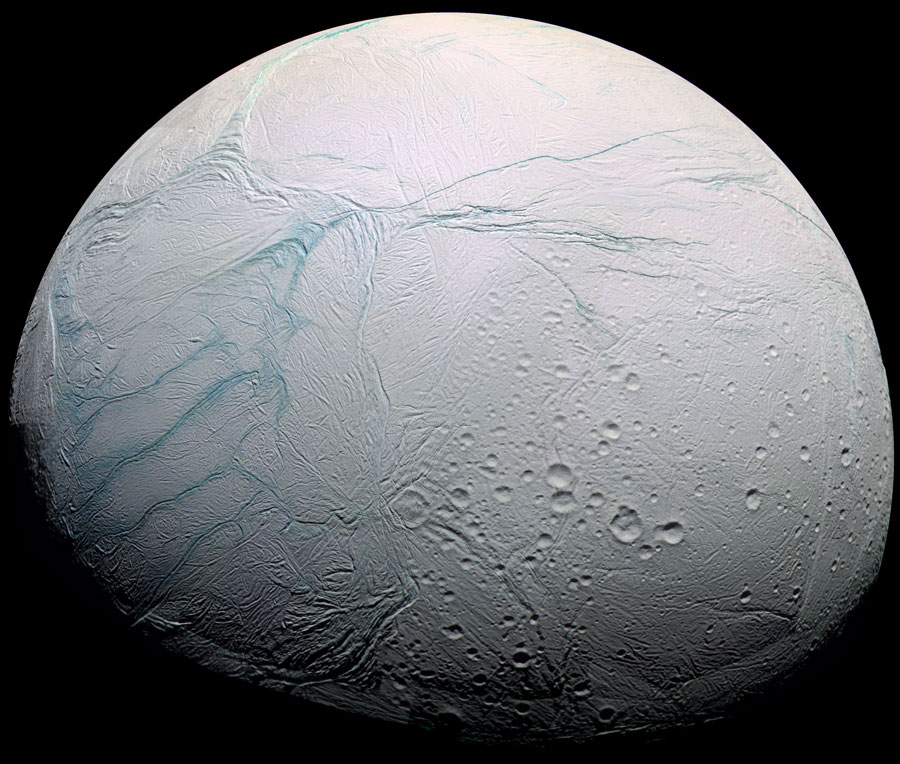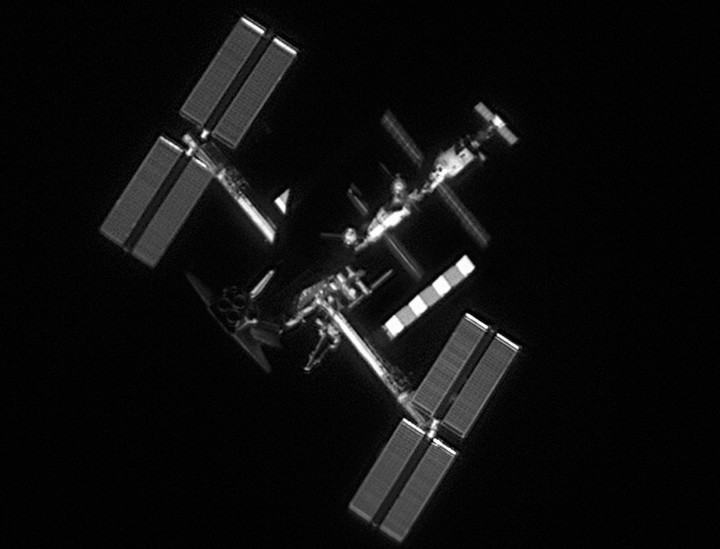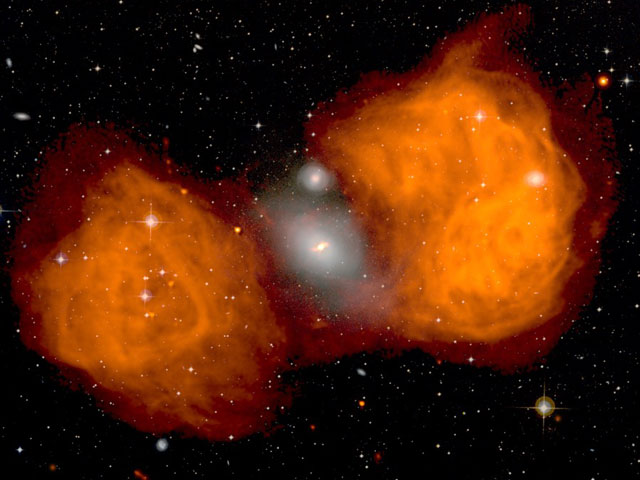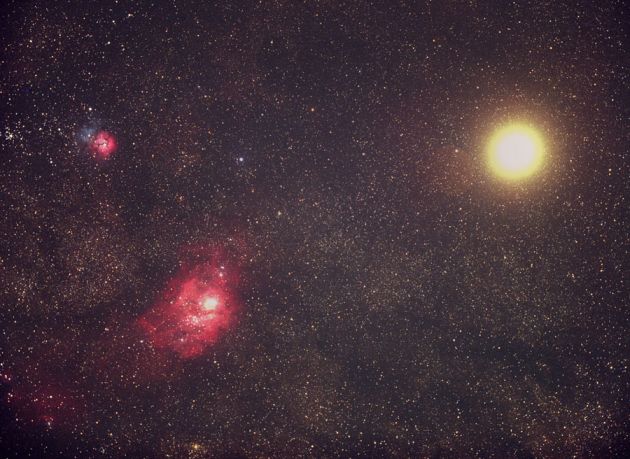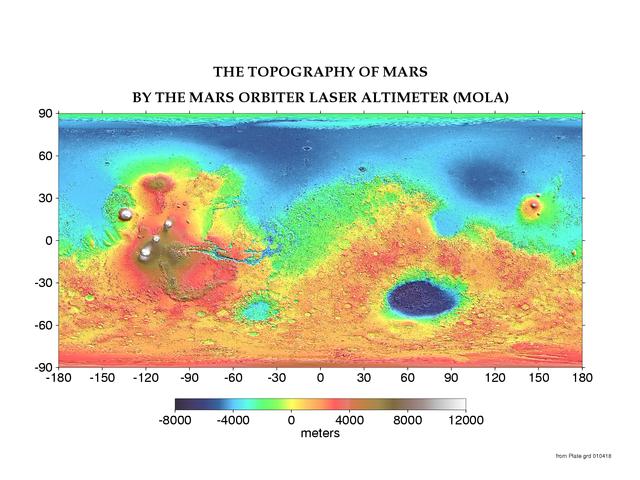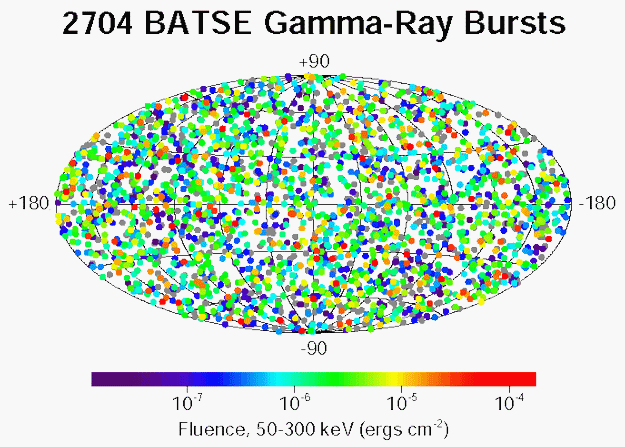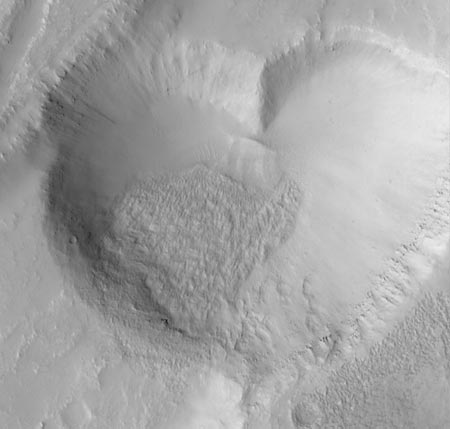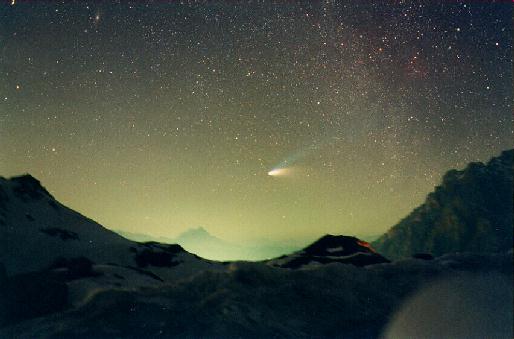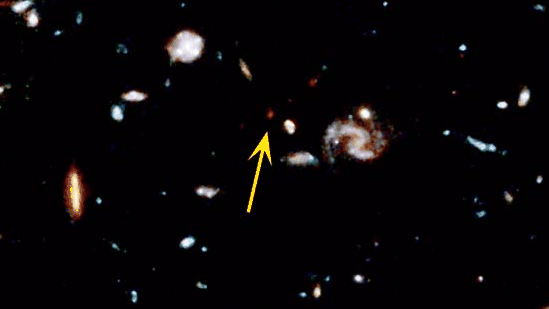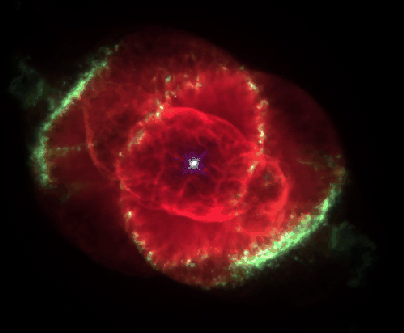| << Previous | Index | Next >> |
2015 It is still not known why the Sun's light is missing some colors. Here are all the visible colors of the Sun, produced by passing the Sun's light through a prism-like device. The spectrum was created at the McMath-Pierce Solar Observatory and shows, first off, that although our white-appearing Sun emits light of nearly every color, it does indeed appear brightest in yellow-green light. The dark patches in the above spectrum arise from gas at or above the Sun's surface absorbing sunlight emitted below. Since different types of gas absorb different colors of light, it is possible to determine what gasses compose the Sun. Helium, for example, was first discovered in 1870 on a solar spectrum and only later found here on Earth. Today, the majority of spectral absorption lines have been identified - but not all.
2014 Orion's belt runs just along the horizon, seen through Earth's atmosphere and rising in this starry snapshot from low Earth orbit on board the International Space Station. The belt stars, Alnitak, Alnilam, and Mintaka run right to left and Orion's sword, home to the great Orion Nebula, hangs above his belt, an orientation unfamiliar to denizens of the planet's northern hemisphere. That puts bright star Rigel, at the foot of Orion, still higher above Orion's belt. Of course the brightest celestial beacon in the frame is Sirius, alpha star of the constellation Canis Major. The station's Destiny Laboratory module is in the foreground at the top right.
2013 A Full Perigee Moon rose as the Sun set last Sunday. At its closest to Earth it was, by just a bit, the year's brightest and largest Full Moon also known as a Super Moon. Seen from Punta Piedras, Argentina and the mouth of the Rio de La Plata, near Buenos Aires, the Super Moon's light created this magnificent circular lunar halo. Still, the size of a lunar halo is determined by the geometry of six sided water ice crystals in planet Earth's high, thin clouds. The crystals deflect the rays of moonlight more strongly through a minimum angle of 22 degrees. So this halo has an inner radius of 22 degrees, just like the halos of the less-than-super moons. Even more common than a Super Moon, beautiful 22 degree halos can be spotted at any time of year.
2012 The glare of Alpha Centauri, one of the brightest stars in planet Earth's night sky, floods the left side of this southern skyscape. A mere 4.3 light-years distant, Alpha Centauri actually consists of two component stars similar in size to the Sun, locked in a mutual orbit. Much smaller and cooler, a third member of the same star system, Proxima Centauri, lies outside this field of view. Still, the telescopic scene does reveal often overlooked denizens of the Milky Way's crowded galactic plane that lie beyond the glare of Alpha Centauri, including a planetary nebula cataloged as Hen 2-111, an estimated 7,800 light-years away. The gaseous shroud of a dying star, the nebula's brighter core and fainter halo of reddish ionized gas span over twenty light-years, seen just right of picture center. Farther right are two notable open clusters of stars, the compact Pismis 19 also nearly 8,000 light-years away whose light is reddened by intervening dust, and the looser, closer NGC 5617. Just visible in the glare of Alpha Centauri is the dim glow of a shell-like supernova remnant, above and right of the closest star system's bright core.
2011 An expansive nebula of dust is seen to surround red supergiant star Betegeuse in this remarkable high resolution composite, an infrared VLT image from the European Southern Observatory. Betelgeuse itself is outlined by the small, central red circle. If found in our own solar system its diameter would almost encompass the orbit of Jupiter. But the larger envelope of circumstellar dust extends some 60 billion kilometers into space, equivalent to about 400 times the Earth-Sun distance. The dust is likely formed as the swollen atmosphere of the supergiant sheds material into space, a final phase in the evolution of a massive star. Mixing with the interstellar medium, the dust could ultimately form rocky terrestrial planets like Earth. The central bright portion of the outer image has been masked to reveal fainter extended structures. The field of view is 5.63 arcseconds across.
2010 What's happened to the Moon? This past weekend, once again, part of the Moon moved through the Earth's shadow. This happens about once or twice a year, on the average, but not each month since the Moon's orbit around the Earth is slightly tilted. Pictured above, the face of a full moon is partly blocked by Earth's clouds, and partly darkened on the upper right by Earth's umbral shadow. Clouds permitting, the partial lunar eclipse was visible from the half of the Earth facing the Moon at the time of the eclipse, which included much of Earth's Pacific Rim. On July 11, a total eclipse of the Sun will be visible in a thin swath of Earth crossing the southern Pacific Ocean.
2009 Do underground oceans vent through the tiger stripes on Saturn's moon Enceladus? Long features dubbed tiger stripes are known to be spewing ice from the moon's icy interior into space, creating a cloud of fine ice particles over the moon's South Pole and creating Saturn's mysterious E-ring. Evidence for this has come from the robot Cassini spacecraft now orbiting Saturn. Pictured above, a high resolution image of Enceladus is shown from a close flyby. The unusual surface features dubbed tiger stripes are visible in false-color blue. Why Enceladus is active remains a mystery, as the neighboring moon Mimas, approximately the same size, appears quite dead. Most recently, an analysis of dust captured by Cassini found evidence for sodium as expected in a deep salty ocean. Conversely however, recent Earth-based observations of ice ejected by Enceladus into Saturn's E-Ring showed no evidence of the expected sodium. Such research is particularly interesting since such an ocean would be a candidate to contain life.
2008 A weekend trip for astrophotography in central Australia can result in gorgeous skyscapes. In this example recorded in March of 2006, the center of our Milky Way Galaxy rises over planet Earth's horizon and the large sandstone formation called Uluru, also known as Ayers Rock. After setting up two cameras to automatically image this celestial scene in a series of exposures, one through a wide-angle and the other through a telephoto lens, photographer Joseph Brimacombe briefly turned his back to set up other equipment. To his surprise, the ground around him suddenly lit up with the brilliant flash of a fireball meteor. To his delight, both cameras captured the bright meteor streak. Highlighted in the telephoto view (inset), the fireball trail shines through cloud banks, just left of Ayers Rock.
2007
2006 Nebulae are perhaps as famous for being identified with familiar shapes as cats are for getting into trouble. Still, no known cat could have created the vast Cat's Paw Nebula visible in Scorpius. At 5,500 light years distant, Cat's Paw is an emission nebula with a red color that originates from an abundance of ionized hydrogen atoms. Alternatively known as the Bear Claw Nebula or NGC 6334, stars nearly ten times the mass of our Sun have been born there in only the past few million years. This deep wide-field image of the Cat's Paw nebula was photographed from New South Wales, Australia.
2005 Together, the radio lobes span over one million light years -- what caused them? In the center is a large but peculiar elliptical galaxy dubbed NGC 1316. Detailed inspection of the NGC 1316 system indicates that it began absorbing a small neighboring galaxy about 100 million years ago. Gas from the galactic collision has fallen inward toward the massive central black hole, with friction heating the gas to 10 million degrees. For reasons not yet well understood, two oppositely pointed fast moving jets of particles then developed, eventually smashing into the ambient material on either side of the giant elliptical galaxy. The result is a huge reservoir of hot gas that emits radio waves, observed as the orange (false-color) radio lobes in the above image. The radio image is superposed on an optical survey image of the same part of the sky. Strange patterns in the radio lobes likely indicate slight changes in the directions of the jets.
2004 The Spirit robotic rover on Mars has now reached the Columbia Hills on Mars. Two of the hills are shown on approach near the beginning of June. The above true-color picture shows very nearly what a human would see from Spirit's vantage point. The red color of the rocks, hills, and even the sky is caused by pervasive rusting sand. Spirit has now traveled over 3 kilometers since it bounced down onto the red planet in January. The robotic explorer, controlled and programmed remotely from Earth, is now investigating a rock called Pot of Gold. On the other side of Mars, Spirit's twin Opportunity is now inspecting unusual rocks inside a pit dubbed Endurance crater.
2003 A telescopic tour of the constellation Sagittarius offers the many bright clusters and nebulae of dimensioned space in a starscape surrounding the galactic center. This gorgeous color deep-sky photograph visits two such lovely sights, cataloged by the 18th century cosmic tourist Charles Messier as M8 and M20. M20 (upper left), the Trifid Nebula, presents a striking contrast in red/blue colors and dark dust lanes. Just below and to the right is the expansive, alluring red glow of M8, the Lagoon Nebula. Both nebulae are a few thousand light-years distant but at the far right, the dominant celestial beacon is a "local" source, the planet Mars. Just passing through Sagittarius and strongly overexposed in this picture, the Red Planet was a short 4 light-minutes away. Now headed for its closest approach to planet Earth in recorded history, Mars rises in the east southeast by midnight shining brightly at about -1.4 magnitude. Urban imager Michael Cole recorded this photograph at 3:00 AM on May 20th, 2001 in clear skies over Camp Hancock, Oregon, USA.
2002 Can the Hubble Space Telescope take a picture that shows the Apollo lunar modules on the Moon? With its 2.4 meter diameter mirror, the smallest object that the Hubble can resolve at the Moon's distance of around 400,000 kilometers is about 80 meters across. So, from low Earth orbit even Hubble's sharp vision can not image the Apollo lunar module descent stages, at most a few meters across, left behind at the lunar landing sites. A space telescope over ten times the size of Hubble could ... or a much smaller telescope in close lunar orbit. In fact, this picture does just resolve Apollo 17's Lunar Module, Challenger, and its shadow on the cratered floor of the Taurus-Littrow valley in the Moon's Mare Serenitatis. It was taken in 1972 from the Apollo 17 Command Module, America, orbiting about 100 kilometers above the Moon's surface and covers an area about 1.1 kilometers wide. Using a web site created by Dan Durda of Southwest Research Institute, armchair astronauts can explore orbital views of this and the 5 other Apollo lunar landing sites.
2001 Mars has its ups and downs. Visible on the above interactive topographic map of the surface of Mars are giant volcanoes, deep valleys, impact craters, and terrain considered unusual and even mysterious. Particularly notable are the volcanoes of the Tharsis province, visible on the left in (false-color) red and white, which are taller than any mountains on Earth. Just to the left of center is Valles Marineris, a canyon much longer and deeper than Earth's Grand Canyon. On the right in blue is the Hellas Planitia, a basin over 2000 kilometers wide that was likely created by a collision with an asteroid. Mars has many smooth lowlands in the north, and many rough highlands in the south. This map was created by the Mars Orbital Laser Altimeter (MOLA) on board the robot Mars Global Surveyor currently orbiting Mars. MOLA measures heights on Mars by precisely determining the time it takes for a low power laser beam to bounce off the surface. Zoom in by clicking anywhere on the above map.
2000 What causes the most powerful explosions in the universe? The BATSE modules that flew on the Compton Gamma Ray Observatory allowed more insight into enigmatic gamma-ray burst (GRB) explosions than ever before. From 1991-2000, BATSE detected 2704 GRBs, much more than ever previously recorded. The above final sky map of GRB locations (and fluence) shows them to occur at random locations on the sky - strong evidence that GRBs occur across our universe and not in sky bands indicative of our Solar System or our Galaxy. As with any successful mission, answers create more questions, and astronomers continue to puzzle over what object creates a GRB, and what happens in the initial stages of the explosion. BATSE's legacy includes recording 1190 gamma-ray flares from the Sun and the discovery of Terrestrial Gamma Flashes, unusual bursts of gamma rays that emanate from the Earth itself. To protect people from an uncontrolled re-entry, Compton was recently crashed into the Pacific Ocean.
1999 Are Martians trying to tell us something? An indentation has been recently photographed on Mars that resembles a heart, a common human symbol for love. Because intelligent Martians have never been known to exist, and because formations with similarities have been found that clearly result from natural phenomena, the pit shown above is thought not to be a form of interplanetary communication. Many scientists believe instead that the right-most wall of the two-kilometer wide heart-shaped pit was created by a naturally occurring graben, a surface drop caused by expansion along a fault-line. Perhaps love is easier to find here on Earth.
1998 In 1997, Comet Hale-Bopp became much brighter than any surrounding stars. It could be seen even over bright city lights. Out away from city lights, however, it put on quite a spectacular show. Here Comet Hale-Bopp was photographed last March above Val Parola Pass in the Dolomite mountains surrounding Cortina d'Ampezzo, Italy. Comet Hale-Bopp's blue ion tail was created when fast moving particles from the solar wind strike ions expelled from the comet's nucleus. The white dust tail was composed of larger particles of dust and ice expelled by the nucleus that orbit behind the comet. Observations have shown that Comet Hale-Bopp's nucleus spins about once every 12 hours. Comet Hale-Bopp is still visible to those in the right place with a good telescope.
1997 "Yes, I have been to Barsoom again ..." begins John Carter in Edgar Rice Burroughs' 1913 science fiction classic "The Gods of Mars". In Burroughs' novels describing Carter's adventures on Mars, "Barsoom" is the local name for the red planet. Mars continues to inspire Earthdwellers' interests and imagination. Soon it will again be invaded by spacecraft from Earth. This dramatic picture of a crescent Mars was taken by NASA's Viking 2 spacecraft in 1976.
1996 Researchers believe that the faint reddish smudge indicated by the arrow in the image above is a candidate for the most distant known galaxy which may have existed only a few hundred million years after the Big Bang. The image is part of the Hubble Deep Field, the Hubble Space Telescope's deepest yet picture of the Universe. Made in December 1995 by staring for ten consecutive days with the Hubble, astronomers have been intently studying the resulting deep field image filled with remote galaxies for clues to what galaxies and the Universe looked like in the distant past. While nearby galaxies are easily detected in the image - some seen here have visible elliptical and even spiral structures - the most distant (and therefore oldest) galaxies must be identified by examining their appearance in different wavelengths of light. Based on this technique, six of the most distant galaxies in the Deep Field appear to be farther away than even quasars.
1995 Three thousand light years away, a dying star throws off shells of glowing gas. This Hubble Space Telescope image reveals "The Cat's Eye Nebula" to be one of the most complex "planetary nebulae" known. In fact, the features seen in this image are so complex that astronomers suspect the visible central star may actually be a double star system. The term planetary nebula, used to describe this general class of objects, is misleading. Although these objects may appear round and planet-like in small telescopes, high resolution images reveal them to be stars surrounded by cocoons of gas blown off in the late stages of evolution.
| << Previous | Index | Next >> |

